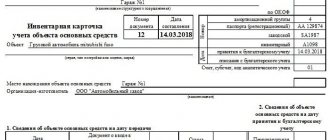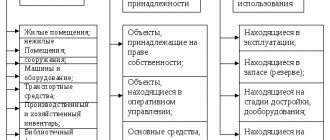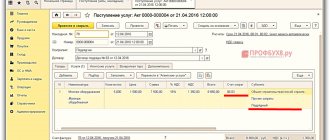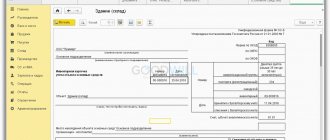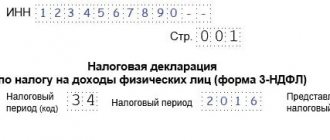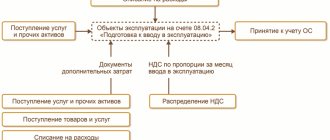Why is numbering needed?
Accountants who have been working at enterprises for more than one year know that their organization has fixed assets on its balance sheet, but not everyone in practice is faced with the need to accept a new fixed asset item. Some accounting workers have no idea how to correctly carry out this procedure, register an object in the accounting registers and reflect it on the balance sheet. There are many reasons why an inventory number of fixed assets is necessary:
- The presence of a large number of objects at the enterprise;
- Constant movements of material assets;
- Existence of leased buildings, machinery, machinery and equipment;
- Regular inventories of the organization's funds.
Knowing how inventory numbers are assigned to fixed assets, an enterprise accountant will constantly have up-to-date information about the state of fixed assets accounting and promptly provide it to the organization’s management and regulatory authorities.
The official document that you need to refer to when resolving this issue is the Methodological Guidelines for Accounting for Fixed Assets, approved by Order of the Ministry of Finance of the Russian Federation on October 13, 2003 No. 91 n. Here we will only briefly outline the necessary steps and the approximate sequence of the procedure.
Basic Rules
- Each OS object is assigned an inventory number once for the entire period of its operation.
- If an object consists of several parts, each is numbered separately.
- The number of an object written off the balance sheet should not be assigned to other types of property of the enterprise for 5 years.
- Moving the OS within the enterprise does not serve as a reason to change the number.
- Leased funds can be accounted for by numbers assigned by the lessor.
Numbering of fixed assets
The Order on the accounting policy of an enterprise must include a clause on how to assign inventory numbers to fixed assets. The numbering order of the OS is reflected here, that is, the inventory number, how many digits it can have, is regulated only by this document. In enterprises where the number of objects is small, you can use simple numbering: 001, 002, 003, etc. For a large number of objects, a more complex system is used, let’s take No. 0104001, where:
01 - code in synthetic accounting (Chart of Accounts);
04 — code of a structural unit of the organization (warehouse, workshop, office);
001 - serial number of OS in the list of items similar in purpose.
Inventory number example:
A forklift has arrived at warehouse No. 2, and the same warehouse already has one. The inventory number of a new forklift can be set using the above method:
- 01 - account number in the Chart of Accounts;
- 02 - warehouse number;
- 002 is the serial number of forklifts in this warehouse.
In this case, the number will be 0102002.
Method of applying the number to the OS
In the practice of accountants, there are cases when it is impossible to apply numbering to an object using accessible methods; in such situations, data about the operating system is stored only on accounting registers. Objects to be numbered can be marked using any method possible for the organization:
- Using paint and stencil:
- Apply stickers or tokens;
- Use engraved plates.
Advice. Do not forget that by applying the inventory number incorrectly, you can spoil the numbering object itself; carefully consider all the nuances before you begin to act.
The head and chief accountant of the organization must constantly monitor the correct and timely registration of the movement of fixed assets, this will ensure their safety, allow for prompt receipt of clear information, and will help in organizing the entire work of the enterprise.
Documenting
Well, in conclusion, let’s say a few words about documenting all the above rules. As we have already said, “accounting numerology” is not regulated in any way by law. This means that the organization can implement the listed rules independently by approving the corresponding local act.
There are several ways to do this. For example, add a corresponding section to the organization’s accounting policy, or make an appendix to it. However, we do not recommend using this option, because... The accounting policy is subject to special rules regarding the introduction of changes and adjustments (clauses 6 and 7 of Article 8 of the Accounting Law). Therefore, it is not worth introducing additional provisions into it, so as not to deprive yourself of freedom of maneuver.
It is better, in our opinion, to use another option - to include rules for numbering objects in the Regulations on conducting an inventory in an organization. In such a document, the numbering rules will look quite logical. And it would be useful to familiarize yourself with them not only for the accountant, but also for any employee included in the inventory commission.
Finally, you can approve a separate document in the organization - Regulations on the procedure for assigning inventory numbers.
Source of the article: https://www.buhonline.ru/pub/beginner/2014/11/9181
Room requirements
By and large, there are only two requirements for an inventory number: the number must be unique, and the numbering system must be orderly.
Uniqueness refers to the assignment of only one unique inventory number to one object. Simply put, the same number cannot be assigned to two or more objects and, conversely, one object should not be assigned two or more inventory numbers. Moreover, we recommend adhering to this rule even if the object has been removed from the balance sheet. To avoid possible confusion, it is better not to assign the number of a retired object to a new one. After all, documentation for the retired object continues to be stored in the organization, and mixing numbers can lead to errors.
As for orderliness, here we are talking about arranging them in a certain system, and not about creating numbers randomly. This allows the accountant, without looking at the object card, to find out its main characteristics from the first numbers, which significantly speeds up the process of inventory and accounting. Agree, when it is immediately clear from the number what type of object it is, when it was purchased and where it is located, this is convenient.
We put the number correctly
Typically, inventory numbers are applied directly to the object. However, there are nuances here too. First of all, it is worth specifying where exactly the number is applied. This will greatly simplify the inventory process itself, since the commission will know exactly where to look for the number and will not have to examine the object from all sides in search of the “cherished” numbers. In addition, this approach will improve the aesthetic appearance of the objects - they will look neat even after many years.
For example, you can establish a rule in your organization that the inventory number on machinery and equipment is always applied next to the factory number (easy to find; this place is protected from harmful influences). And on cabinets and bedside tables that have doors - inside, on the upper inner corner of the left door (easy to apply; less likely to be damaged during use and cleaning; visible during any rearrangement). By the same logic, on tables it is better to place the number on the inside of the leg or on the side panel.
The way the number is applied is also important. When applying a number, there should be no damage to the object itself. After all, it is quite possible that it will have to be sold in the future. This means the number will need to be deleted. And, preferably, without a trace. This also needs to be taken into account. Therefore, it is recommended to mark objects by attaching a token, or by applying a number with paint, a marker, or by attaching an adhesive sticker (for numbers and methods of applying them, see also “What modern tools exist for fast and high-quality inventory”).
Finally, some objects are too small to be numbered. In such cases, the number may not be applied at all, which must be noted on the inventory card. In this case, it is advisable to configure the accounting program in such a way that the accountant can quickly generate a list of such unmarked objects indicating their physical location. This will speed up the inventory process.
What is an inventory number
Fixed assets can be used in work only after they have been accepted for accounting. The unit of such accounting is an inventory object. To monitor the safety of items, their use and condition, they are assigned numbers.
To organize accounting and ensure control over the safety of fixed assets, each inventory item of fixed assets must be assigned a corresponding inventory number when accepting them for accounting.
Order of the Ministry of Finance of the Russian Federation dated October 13, 2003 N 91n (as amended on December 24, 2010) “On approval of the Methodological Guidelines for Accounting of Fixed Assets”, paragraph 1, paragraphs. eleven
Features of number assignment:
- The number is indicated on each object.
- You cannot change the code while it is in use.
- A number can be assigned to an object whose parts have an equal useful life.
Parts of a single object cannot be assigned different codes. It is also not possible to combine several objects under one number. This type of numbering is used only in the company’s internal accounting. When transferring ownership, the number is not retained.
Inventory number and features of its use
An inventory number is assigned to a property at the time it is accepted for registration. After this, it acquires the status of an inventory object - a control unit. The number is applied to the object using durable paint, a barcode, engraving, using a token that cannot be quickly and discreetly removed, or in another similar way. The number must be applied so that during an inventory it can be easily and without errors identified with the BU data.
The main objects in relation to which management is organized in this way and control is exercised are:
- OS - fixed assets, objects of property of the organization that have been in operation for more than a year, are intended for production needs, and the cost of which is a legally defined amount;
- intangible objects, assets (IMA) - these include products of intellectual labor, for example, technological developments, software development, trademarks, brand names and other objects that do not have a material form, but which can in the future bring material benefits (see. Civil Code of the Russian Federation Article 1225-1, PBU 14/07);
- non-produced objects, assets - these are natural objects, subsoil, lands, water bodies, etc.
Objects costing less than 3 thousand rubles. no inventory number needed.
The following mandatory requirements apply to inventory numbers:
- they should not be duplicated;
- they must be assigned in order.
In addition, when using inventory numbers in accounting records, it is important to be guided by the following important information:
- The inventory number is applied in the presence of a commission specially created for this purpose and recorded in the inventory number journal.
- If the inventory object is a whole consisting of separate functional parts, a number is applied to each part.
- Moving an inventory item within the organization or its divisions is not a reason to change the number or adjust it. The inventory number does not change during the entire operation of the object to which it is assigned.
- If fixed assets are leased by a company, they are usually accounted for by numbers assigned by the lessor. At the same time, from Resolution 11 of the Arbitration Court of Appeal No. A55-24142/2013 dated 04/28/14, it follows that when the rights to an inventory object are transferred, for example, when signing a leasing agreement, it may be assigned a new inventory number of the organization that acquired such rights. It is argued that the assignment of inv. numbers are an internal matter of the organization.
- The inventory number of an object deregistered (sold, written off, etc.) cannot be assigned to another object in the same organization.
What objects are subject to numbering
Codes are assigned to the following objects:
- Fixed assets. These are tangible items that can be used in work for 12 months or more. For example, equipment, tools, furniture, etc.
- Intangible objects. For example, a movie, a multimedia product, technology.
- Non-produced assets. These are the resources of the earth's interior, land plots, etc.
The codes are indicated in the documentation for accounting for fixed assets and are used during inventory. Movable and immovable property is taken into account.
Library collection objects are assigned codes regardless of cost. All objects are subject to numbering, regardless of whether they are used in work or are in stock.
How to assign numbers to fixed assets and other types of objects
The code is applied by an employee who is financially responsible. The procedure is carried out under the supervision of a member of the commission for the receipt and disposal of assets.
Numbers are applied to accounting objects. It is more convenient to use indelible polypropylene labels . You can also apply the number with paint or attach a metal token with an inscription to the item. You can also use other application methods: engraving, welding, stamping. The code must be applied in such a way that it cannot be corrected or replaced. The number must be clear and easy to read.
Sometimes an object has special properties during operation, which does not allow you to put a number on it. In this case, the accounting records describe the item and its number, and note the absence of a number directly on the object.
- The code does not change during use.
- If parts of an object are accounted for as separate units, then each part is assigned a separate code.
- If parts of an object are counted as one unit, then a single code is indicated.
- When moving to another department, the code does not change.
- After the object is written off, at least 5 years must pass, after which the inventory number can be reused.
- If an enterprise uses an object under a lease agreement, it can account for it using the previous number from the lessor.
To make the number easy to read, it is recommended to adhere to the following layout:
- The first part of the number is the accounting account or sub-account of the object.
- The second part is the company branch code.
- The third is the serial number of the object.
Examples and samples
The numbers are recorded in the inventory number register. The title page of the accounting book contains information about the organization, as well as the data of the responsible employee.
Name of the organization, division, date, full name and personnel number of the responsible accountant
On the second page, information about the object is filled in.
Information is recorded as it becomes available.
Residual value, revaluation, internal movements of the object
An inventory card is created for each object. It records all movements of the object.
Information about the object, its revaluation and movement
The back of the card describes the changes that occur to the object during operation.
Repair costs, value changes and individual property characteristics
The accountant fills out and signs the documents. Numbers can be assigned using computer programs. This can be simple sequential numbering or defining a code using a pattern. The latter method is appropriate to use in large organizations with a wide branch network.
Example with a budget organization
The system is capable of composing complex numbers of up to 30 characters.
General drafting rules
The legislation does not provide for a special procedure for assigning numbers. The organization has the right to independently develop these regulations. The procedure is prescribed in the accounting policy of the enterprise or another act.
The main requirement is to indicate a unique number for each object. It is unacceptable for designations to be repeated. If a fixed asset is deregistered, its number can be assigned to another object after at least 5 years.
The numbers must be sequential. In large organizations, it is better to develop guidelines for assigning codes. The number may consist of several parts: a company branch, a division, a code within a division. When transferring funds to other branches, they will not be lost. Small firms can use simple numbering starting from 1.
Method of applying the number to the OS
In the practice of accountants, there are cases when it is impossible to apply numbering to an object using accessible methods; in such situations, data about the operating system is stored only on accounting registers. Objects to be numbered can be marked using any method possible for the organization:
- Using paint and stencil:
- Apply stickers or tokens;
- Use engraved plates.
Advice. Do not forget that by applying the inventory number incorrectly, you can spoil the numbering object itself; carefully consider all the nuances before you begin to act.
The head and chief accountant of the organization must constantly monitor the correct and timely registration of the movement of fixed assets, this will ensure their safety, allow for prompt receipt of clear information, and will help in organizing the entire work of the enterprise.
In the certification of workplaces for working conditions there was no such thing as an “individual workplace number”. Neither the Federal Law of December 28, 2013 N 426-FZ “On Special Assessment of Working Conditions”, nor the “Methodology for Conducting a Special Assessment of Working Conditions”, approved by Order of the Ministry of Labor of Russia of January 24, 2014 N 33n, says anything about the mechanism for assigning an individual number. because the employer himself determines within his organization on what basis to assign these individual numbers. An individual workplace number is assigned by the employer independently and the number of characters in the number should be no more than 8: from 1 to 99999999. In practice, it happens that the individual workplace number coincides with the serial number of the workplace in the list compiled during a special assessment of working conditions . Individual numbers for workplaces, taking into account the structure of the organization and the staffing table, can be assigned by the commission for conducting special labor assessments when compiling a list of workplaces at which a special assessment of working conditions will be carried out. A HR specialist can also assign individual numbers to workplaces.
Why is an individual number required for a workplace? The results of the special assessment of working conditions, in accordance with Article 18 of the Federal Law of December 28, 2013 N 426-FZ “On the Special Assessment of Working Conditions,” are subject to transfer to the Federal State Information System for recording the results of the special assessment of working conditions (hereinafter referred to as FSIS). Along with the number of employees employed at a given workplace, SNILS of employees, working conditions, guarantees, compensation and other information, the individual workplace number is also transmitted to the accounting information system. Those. the relevant authorities, by going to the FSIS, can obtain information about a workplace with a certain number in a certain organization, which employees worked there with which SNILS, in what working conditions, what guarantees and compensation were provided to them and draw a conclusion about the need to provide a preferential pension or opportunity occurrence of occupational disease.
The individual number is associated with working conditions in the workplace, as well as guarantees and compensation provided to the employee in the presence of a harmful or dangerous class of working conditions. In this regard, the next time (in 5 years) the SOUT is carried out at this workplace, the individual number remains unchanged.
Still have questions after reading the article? You can ask our experts by phone. or write to email: [email protected]
How to create an inventory number: example
A computer was used for accounting. The object was issued to unit number 9. The last registered code is 0121.
The computer belongs to the list of “Machinery and Equipment”. As a result, the object was registered under number 9101340122:
- 9 - department code.
- 101 - synthetic accounting code.
- 34 - analytical account code.
- 122 — object number in order.
During the reorganization of an enterprise from one form of ownership to another, its owner changes. Each new owner sets new inventory numbers for all objects.
The cadastral registration authorities store information about buildings: the inventory number of the house and an additional code in the form of numbers or letters. This number allows you to determine the area and type of property.
There are no strict instructions on how to correct errors when assigning numbers. Depending on the situation, you can complete the item, write it off, or register a new item.
Inventory of objects must be carried out by attentive and responsible accountants according to regulations. Errors in accounting for funds are punished by regulatory authorities. The company will pay fines if the accounting procedure is violated.
How to build a numbering system
What information exactly can and should be “encoded” in the inventory number? For example, it can reflect an accounting account; depreciation group number; OKOF code; period of registration (year, month); division (branch) or building (building) in which the facility will be used. That is, in essence, the inventory number can be similar to the VIN of a car, which also encrypts all the information, from the place and year of manufacture to the configuration. And again, by analogy with the automobile industry, the inventory number can consist not only of numbers, but also of letters. For example, letters can be used to encode the period of acceptance for accounting, or the location of the object.
When choosing the information that needs to be encoded in the number, you must remember that an overly complex and (or) redundant structure of the inventory number is inconvenient to work with. Accordingly, the number should include only those criteria that will actually be used in the work. And, of course, when compiling a number, you need to take into account the capabilities of the software used in the company: whether they can support all the criteria “coded” in the number.
Inventory number structure
This characteristic largely depends on the internal needs of the company:
- its size;
- structure and presence of divisions;
- opportunities and resources in the process of organizing accounting.
Thus, a small organization that has a minimum number of divisions and a limited number of accounting objects can use simple numbering of the form: 01, 02, 03, etc. If objects are located on different accounting accounts, in different departments, it is advisable to include this information in the inventory number, for example:
- 04 — intangible assets accounting account;
- 03 - code of the department in which the object is located;
- 02 is the sequential number of this object in the division.
We receive inventory number 040302.
It is also acceptable to use alphabetic characters and abbreviations for the names of departments:
- "AXO" - for accounting and financial services of the economic service;
- "SKL" - warehouse, etc.
Attention! When determining the structure of an object’s inventory number, it is necessary to take into account the possibility of its movement across company divisions. Information must be generated in such a way as to ensure error-free identification of an object with BU data.
The procedure must be recorded in the company's accounting policies.
Assigning inventory numbers to fixed assets
General approaches to assigning inventory numbers to fixed assets are specified in the Guidelines for accounting of fixed assets (Order of the Ministry of Finance of the Russian Federation No. 91n dated 10/13/2003 (as amended on 12/24/2010)) and Instruction No. 157n (Order of the Ministry of Finance of the Russian Federation dated 12/01/2010). According to them:
- the inventory number is unique, that is, there should not be two fixed assets with the same inventory numbers,
- if the object is composite, that is, it consists of elements that make up a single whole, then all parts of the complex fixed asset are allocated one single inventory number,
- inventory numbers must be in order,
- the inventory number does not change when the location of a fixed asset object changes within the same organization,
- once an inventory number is attached to a fixed asset, it remains with it throughout the entire time it is in the organization,
- inventory numbers of fixed assets removed from balance sheet accounting are not assigned to newly accepted fixed assets for accounting,
- For a fixed asset received by an organization under a lease agreement, the same inventory number may be used that was assigned to the fixed asset by the lessor.
We put the number correctly
Typically, inventory numbers are applied directly to the object. However, there are nuances here too. First of all, it is worth specifying where exactly the number is applied. This will greatly simplify the inventory process itself, since the commission will know exactly where to look for the number and will not have to examine the object from all sides in search of the “cherished” numbers. In addition, this approach will improve the aesthetic appearance of the objects - they will look neat even after many years.
For example, you can establish a rule in your organization that the inventory number on machinery and equipment is always applied next to the factory number (easy to find; this place is protected from harmful influences). And on cabinets and bedside tables that have doors - inside, on the upper inner corner of the left door (easy to apply; less likely to be damaged during use and cleaning; visible during any rearrangement). By the same logic, on tables it is better to place the number on the inside of the leg or on the side panel.
Finally, some objects are too small to be numbered. In such cases, the number may not be applied at all, which must be noted on the inventory card. In this case, it is advisable to configure the accounting program in such a way that the accountant can quickly generate a list of such unmarked objects indicating their physical location. This will speed up the inventory process.
Responsibility for failure to take inventory
The law does not provide for liability for failure to carry out an inventory. However, the inspection may fine you for unreliable accounting and reporting data (Article 120 of the Tax Code of the Russian Federation; Article 15.11 of the Code of Administrative Offenses of the Russian Federation). True, to do this she will have to find the discrepancies between the credentials and the real ones herself. Although this is not easy to do in previous periods, it is not impossible.
We recommend watching the recording of the webinar “How to conduct and process an inventory in accounting and tax accounting.” The lecturer will use practical examples to show how to make adjustments in accounting if surpluses or shortages are identified during inventory. He will also examine the most controversial and challenging issues that arise during the inventory process.
Reply from 12/08/2015:
Instruction No. 174n (Appendix No. 2 to Order No. 174n of the Ministry of Finance of Russia dated December 16, 2010) does not contain any special instructions regarding the procedure for generating inventory numbers of fixed assets in budgetary institutions.
The only norm of legislation on accounting in state (municipal) institutions regulating the procedure for assigning inventory numbers to fixed assets is clause 46 of Instruction No. 157n (Appendix No. 2 to Order of the Ministry of Finance of Russia dated December 1, 2010 No. 157n).
According to paragraph 46 of Instruction No. 157n, each inventory item of real estate, as well as an inventory item of movable property, except for objects worth up to 3,000 rubles inclusive and objects of the library collection, regardless of their value, is assigned a unique inventory serial number (hereinafter referred to as the inventory number) regardless of whether it is in operation, in reserve or in storage.
There are two requirements here:
1) The inventory number must be unique. That is, there should not be more than one fixed asset with the same inventory number. Also, paragraph 46 of Order No. 157n states that after writing off a fixed asset, it is unacceptable to reuse its inventory number.
2) The inventory number must be “serial”.
Thus, the legislation does not establish any requirements for the number of digits in the inventory number of a fixed asset and the content of these digits.
According to paragraph 46 of Instruction No. 157n, the inventory number assigned to an object must be designated by the financially responsible person in the presence of an authorized member of the commission for the receipt and disposal of assets by attaching a token to it, applying paint to the accounting object or in another way that ensures the safety of the marking. If the fixed asset object is complex (a complex of structurally articulated objects), i.e. includes separate elements (structural objects) that together form a single whole, then each such element (structural object) must be marked with an inventory number assigned to the fixed asset (complex object, complex of structurally articulated objects).
Consequently, the absence of inventory numbers on fixed assets (if it is possible to apply them) or unreliably applied inventory numbers (for example, glued with tape), the absence of inventory numbers on the components of the complex can be considered a serious violation of accounting standards.
According to clause 46 of Instruction No. 157n, the inventory number assigned to an object of fixed assets is retained by it for the entire period of its presence in the institution.
Therefore, inventory numbers cannot be changed.
Accounting for the tenant
An important point is that the leased asset, which is registered by the tenant, must strictly comply with specific requirements:
- the object is used exclusively in the main (production and economic) activities of the organization;
- the regulated useful life of this asset exceeds twelve months;
- there is a real possibility of profitable use of the fixed asset;
- the asset was acquired by the owner not for subsequent resale to third parties.
Thus, the compliance of a property object with all of the above criteria is the basis for its registration as an asset related to fixed assets.
The fact of transfer and acceptance of an asset under a lease agreement is necessarily certified by the execution of the corresponding act, which, as is known, is a necessary addition (appendix) to the agreement concluded between the lessor and the lessee.
Operating lease of fixed assets
Economic relations involving the transfer (provision) and acceptance (receipt) of a specific fixed asset item for a certain fee under temporary operation conditions are most often carried out under an operating lease.
A characteristic feature of this transaction is the immutability of the owner of the leased asset.
Operation of an asset provided under an operating lease is permitted solely for its intended purpose - only to perform production tasks.
The lessee, however, has the right to improve the technical and operational parameters of the leased equipment (asset), having previously agreed upon the relevant measures with the lessor (owner) of the fixed asset.
How to take into account the value on off-balance sheet account 001?
The fact of acceptance and registration of an asset by the tenant is recorded in the debit of account 001.
At what cost should the asset be accounted for? The fixed asset is accounted for by the lessee at the cost specified in the relevant lease agreement.
The disposal of an asset and its subsequent return to the lessor is reflected by the lessee on the credit of account 001.
By the way, account 001 refers to so-called off-balance sheet accounts in accounting.
Lease payments, which are periodically made by the tenant for the operation of the fixed asset, also require tax and, of course, accounting.
In essence, the rental fee for fixed assets is the direct costs of the tenant, reflected as part of the cost of the main or, alternatively, auxiliary production.
The specific scope of attribution of such costs is determined by the functional purpose of the leased equipment.
Postings
Payments for the lease of fixed assets are taken into account by the tenant enterprise as part of the expenses of its ordinary activities.
For tax accounting, rent is written off by the tenant as expenses that constitute the cost of services, work, and goods.
Taking into account the leased fixed assets, the lessee company draws up the following typical transactions:
| Operation (description) | Account debit | Account credit |
| The leased asset is registered | 001 | |
| The rent payment is included in the costs of the tenant company (excluding VAT) | 44,26,25,20 | 76 |
| The VAT amount is taken into account separately from the rental payment | 19 | 76 |
| The amount of VAT paid is deducted | 68 (according to VAT subaccount) | 19 |
| The rent payment is transferred to the lessor | 76 | 51 |
| The asset is returned to the lessor (upon expiration of the lease agreement) | 001 |
Depreciation
If an asset is used by an organization under an operating lease, the lessee enterprise does not charge depreciation on such an asset.
However, for tax accounting reasons, the lessee can depreciate capital investments (investments) in leased fixed assets on the following basis:
- the lessor of the fixed assets agreed in advance for the tenant to make such capital investments;
- the cost of such capital investments will not be reimbursed by the lessor to the lessee;
- such depreciation is carried out by the lessee during the term of the lease agreement;
- the amounts of such depreciation are calculated according to the regulated useful life of the leased fixed assets.
Typical mistakes when assigning inventory numbers
Inaccuracies and errors made can not only bring chaos to the process of accounting for inventory items, but also lead to negative consequences when conducting external control. This is especially true for municipal unitary enterprises, other government organizations, and subordinate organizations. The most common ones are listed below:
- Discrepancies with the accepted accounting policy: arbitrary change in the length of the number, inclusion of letter designations in it, or, conversely, ignoring them in practice.
- Applying the number in a way that does not ensure its safety during the entire operation of the object: with weak dye, by gluing labels, etc.
- Failure to affix an inventory number due to the alleged impossibility of affixing it. Indeed, instruction 157n allows you not to physically affix this number, but only to enter it into the control unit registers under appropriate conditions. However, if the control commission discovers that the application was in fact possible, the organization may have problems.
- Applying an inventory number to objects arbitrarily, unnecessarily. Example: numbering an object worth less than 3,000 rubles.
Error 1. Incorrect number structure
There are no special requirements for the formation of inventory numbers either in Instruction No. 157n or in other regulatory legal acts. Therefore, institutions can independently develop a procedure for generating inventory numbers and reflect these rules in their accounting policies. Typically, the structure of the inventory number includes the information that an institution needs for operational accounting of non-financial asset objects, for example, a code for the type of activity where the object is used, a synthetic account code, an analytical account code, or a serial number. The first and quite common mistake is failure to comply with the requirements for the structure of inventory numbers recorded in the accounting policy - for example, if, according to the requirements of the accounting policy, the inventory number must consist of 10 characters, and the inventory number assigned to objects consists of 14 characters (see materials published on the official website of the Chuna district municipality: www.chuna.irkobl.ru, path: Chamber of Control / Results of control activities / Report No. 01-16/06 dated 11/14/2014).
Error 2. Incorrect choice of method for affixing the inventory number
The main methods for affixing inventory numbers assigned to fixed assets are listed in paragraph 46 of Instruction No. 157n. This regulatory document states that the inventory number assigned to an object must be designated by a financially responsible person in the presence of an authorized member of the commission for the receipt and disposal of assets by attaching a token to it, applying paint to the accounting object or in another way that ensures the safety of the marking. Thus, the list of methods for affixing inventory numbers is open, and practice shows that quite often specialists from institutions print out data on inventory numbers on paper and stick them with tape. This method is often used when assigning inventory numbers to stationary objects: benches in the gaming room, table tennis tables, etc. However, this approach often raises objections among inspectors. It is believed that in this case we can say that the inventory numbers are applied in a way that does not ensure their safety, that is, the requirements of paragraph 46 of Instruction No. 157n are violated - see, for example, the information posted on the official website of the Cherepovets municipal district (www. cherra.ru, act of control activities of the control and accounting committee of the Municipal Assembly of the Cherepovets Municipal District dated 10/05/2012 No. 33).
Error 3. Assigning inventory numbers when there is no such need
Instruction No. 157n provides for two situations when assigning separate inventory numbers to a piece of sports equipment is not necessary. Firstly, as we indicated above, this is the low cost of the object. Secondly, the classification of an object as a complex fixed asset or fixed asset with accessories is important. Sports equipment worth up to RUB 3,000. no inventory number is assigned. However, this is often forgotten. As an example, we can cite the materials of one of the audits conducted by the Control and Accounts Chamber of the city of Saratov. Specialists from the regulatory agency established that the institution’s balance sheet included items worth up to 3,000 rubles as fixed assets, including weights, expanders, and dumbbells. In violation of paragraph 46 of Instruction No. 157n, these objects were assigned unique inventory numbers - see the information published on the official website (www.kspsaratov.ru, path: About the chamber / Activities of the chamber / 2013 / Information on the results of an audit of the financial and economic activities of the institution health care "Center for Regenerative Medicine and Rehabilitation"). The basic rules for accounting for complex fixed assets or fixed assets with accessories are as follows (clauses 45 and 46 of Instruction No. 157n). An inventory object of fixed assets is an object with all fixtures and accessories, a separate structurally isolated object, a separate complex of structurally articulated objects. If one structurally articulated object has several parts - fixed assets that have different useful lives, each such part is accounted for as an independent inventory item. But if for a complex of structurally articulated objects consisting of several items, a common useful life for all objects is established, the specified object is taken into account as an independent inventory object. If a fixed asset object is complex (a complex of structurally articulated objects), that is, it includes separate elements (structural objects) that together form a single whole, each such element (structural object) must be marked with an inventory number assigned basic means (complex object, complex of structurally articulated objects). Despite the simplicity and logic of these regulatory rules, physical education and sports institutions may encounter problems when applying them to sports equipment. A typical example is basketball backboards. According to the appendix “Basketball Equipment” to the Rules of the sport “basketball” (approved by Order of the Ministry of Sports and Tourism of the Russian Federation dated May 12, 2010 No. 482), two shield designs are installed in the playing hall, each of which must consist of the following parts: – one shield; – one basket with a ring attached to the shield; – one grid; – one support supporting the shield; – upholstery. Practitioners may wonder how to assign accession numbers for these items. Practice shows that the desire to “play it safe” and record as many small fixed assets as possible in accounting is fraught with claims from inspectors. Thus, based on the materials of one of the inspections of the activities of institutions, the following was recorded as a violation by the control agency. In violation of paragraphs 41, 45, 47 of Instruction No. 157n, the institution assigned different inventory numbers to the devices listed in the accounting records (9 basketball hoops, 9 basketball nets, 9 basketball backboards), which actually represent 9 independent inventory objects - see materials , published on the official website of the Saratov municipal district www.saratov.sarmo.ru, path: Financial and legal sphere / Control and audit department / KRU activities 2015 / Act of the control and audit department of the Saratov municipal district of the Saratov region based on the results of an audit of the financial and economic activities of the Municipal educational institution “Secondary school in the village of Dubki, Saratov district, Saratov region”).
Error 4. Making a decision about the impossibility of affixing an inventory number
As expressly stated in paragraph 46 of Instruction No. 157n, if it is impossible to designate an inventory number on a fixed asset object in cases determined by the requirements of its operation, the inventory number assigned to it is used for accounting purposes with reflection in the relevant accounting registers without applying the fixed asset to the object . For many sports equipment, there is a temptation to apply this paragraph and not indicate the accession numbers. Is it possible to say that the requirements for using sports equipment for team games make it impossible to affix an equipment number? Materials from inspections of the activities of institutions do not always allow us to answer this question positively. In practice, the impossibility of designating an inventory number in cases determined by operational requirements is most often due to the fact that the affixed number is constantly erased and needs to be restored, or the object may deteriorate due to affixing the number. A classic example is dishes (pans, pots), the operating conditions of which require heating to high temperatures. In this case, when accepting the dishes for accounting as fixed assets, a special commission of the institution for the receipt and disposal of assets has the right to determine that, taking into account the special procedure, the inventory numbers on Such categories of fixed assets are not recorded, but are only reflected in the accounting registers. However, in our opinion, this approach should be used with caution in relation to sports equipment. Otherwise, there is a high probability of claims from specialists from regulatory agencies during inspections.
Sources
- https://mofree.ru/calculation/skolko-cifr-dolzhno-byt-v-inventarnom-nomere-chto-takoe.html
- https://ip-spravka.ru/inventarnyiy-nomer-osnovnyih-sredstv.html
- https://assistentus.ru/osnovnye-sredstva/kak-prisvoit-inventarnyj-nomer/
- https://buh-spravka.ru/buhgalterskij-uchet/os-nma-oborudovanie-k-montazhu/inventarnye-nomera-osnovnyh-sredstv.html
- https://praktibuh.ru/buhuchet/vneoborotnye/os/prochee/uchet-arendovannyh-os-u-arendatora.html
- https://www.audit-it.ru/articles/account/assets/a8/882401.html
Assigning numbers to people is a crime
In recent days, one can’t help but get the impression that in the coming “coronavirus era,” we are increasingly witnessing openly panicky sentiments.
And, what is most unpleasant, these sentiments are manifested among those who are called upon to make decisions that are important for all of us, aimed at truly reducing the danger of COVID-19 infection for our citizens and, ultimately, defeating the pandemic virus, by the official authorities. However, the decisions they make, often of an openly panicky nature, as the practice of recent days shows, are not only often not aimed at a real solution to the problem, but, rather, on the contrary, create additional difficulties, and sometimes run counter to the legislation in force in the country, which causes active protests by citizens. The result is collective indignation of people who are forced to go “to the very top” of the Russian power vertical in order to protect their fundamental rights.
Thus, on April 15, a number of news agencies reported that an “Open Letter to Russian President Vladimir Putin” had appeared on the Internet and was intended for everyone to sign, demanding to stop the legal arbitrariness committed by the Moscow authorities. The authors of the letter remind that in Moscow, as in a number of other regions of Russia, a high alert regime has been introduced in connection with the spread of coronavirus infection. This regime was introduced to curb the spread of coronavirus.
“While supporting the need to take certain sanitary and epidemiological measures in order to counter the spread of the disease, we consider it absolutely unacceptable to introduce inadequate and disproportionate restrictions on the constitutional rights of citizens by decisions of Moscow authorities,” the letter says, in particular. The authors ask the head of state to pay attention to the fact that, under the guise of fighting coronavirus, a system of “electronic passes” is being introduced in Moscow, that is, total electronic surveillance of citizens, which is completely unjustified from a sanitary and epidemiological point of view and grossly violates the Constitution and federal laws.
The letter further lists the restrictive measures introduced by the Moscow City Hall regarding access control. To obtain a pass, even to travel to work, citizens must provide all personal data, including passport data, Taxpayer Identification Number, telephone number, vehicle number, employer's name, Taxpayer Identification Number and other data. It is also required to provide information about the route of movement.
The authors of the letter are confident that the introduction of a system of digital passes for movement around the city is unacceptable and completely illegal. It is known that the mayor of Moscow, by his decree on the introduction of a pass regime, violated Articles 23 and 24 of the Constitution of the Russian Federation concerning the inviolability of their private life, protection of honor and good name. In addition, according to Part 3 of Article 55 of the Russian Constitution, “the rights and freedoms of man and citizen may be limited by federal law only to the extent necessary in order to protect the foundations of the constitutional system, morality, health, rights and legitimate interests of other persons, ensuring the country's defense and state security."
None of the existing federal laws in Russia allows the introduction of restrictions on the constitutional rights of citizens established by Part 1 of Art. 23, art. 24 of the Constitution of the Russian Federation, as a condition for movement in “high alert” mode. Moreover, even the “state of emergency” regime does not imply restrictions on the rights specified in Part 3 of Article 56 of the Constitution of the Russian Federation. But there is no state of emergency in Moscow. It can only be introduced by the President of Russia in particularly dangerous situations that directly threaten the life and safety of citizens or the constitutional order of Russia.
The authors of the letter believe that the reason for such actions by authorities in Moscow is solely the “convenience” of monitoring citizens electronically.
The decree of Moscow Mayor Sergei Sobyanin degrades human dignity, as it forces a person to identify himself with a digital number rather than a name. The authors of the letter draw attention to the fact that at the Nuremberg trials (November 20, 1945 - October 1, 1946), the international military tribunal recognized, among the crimes of Nazism, that the practice of assigning numbers to people is a crime against humanity and has no statute of limitations.
“On the eve of the 75th anniversary of the victory in the Great Patriotic War, the adoption in the capital of our Motherland of an act that assigns a license plate to a citizen is a special manifestation of cynicism. According to Art. 21 of the Constitution of the Russian Federation, actions that degrade human dignity are prohibited even during a state of emergency (Part 3 of Article 56 of the Constitution), which does not exist in Moscow,” the letter says.
In addition, Sobyanin’s decree violated several federal laws. This is the Federal Law of the Russian Federation dated July 27, 2006 No. 152-FZ “On Personal Data”; Federal Law of the Russian Federation dated July 27, 2010 No. 210-FZ “On the organization of the provision of state and municipal services.”
In conclusion, the authors of the letter demand that the “guarantor of the Constitution” take measures to counter the unlawful decisions of the authorities of the city of Moscow and other regions to introduce a system of digital passes as a condition for the movement of citizens.
